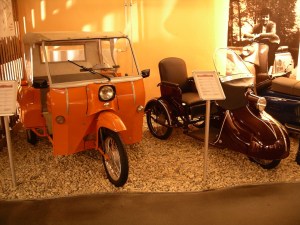Even those two launches did not fully prepare me for coming across the Ducati V8 of German engineer Dieter Hartmann-Wirthwein, who is very much a “can do” kinda guy.
Just four years ago, Dieter undertook his first motorcycle project – creating a four valve-head for a vintage R50 BMW racer – people who know the bike will know the problems. It worked. Next up, Dieter had an idea for creating a compact four cylinder engine from a single cylinder engine using just one conrod. The video contains an animation of his fascinating system which I can guarantee will fascinate anyone who has ever had grease under their fingernails. The system is ingenious, and his next step was to build one
So he took a Honda single cylinder 125 engine, and made it a four cylinder 125, which he installed in a monkey bike for testing. once the engine had worked reliably and powerfully, he decided to take concept and doing something very cool with it – like taking a Ducati 900 V-twin and turning it into a V-8.
The name of the motor is a derivative of the Ford Mustang GT 500 in the film “Gone in 60 seconds” and the entire motorcycle is now nearing completion as an 868cc V8 Ducati – the engine looks a treat, but it’s the workings that mesmerize me. The system he uses to achieve such an astonishingly compact road bike is just fascinating and I am certain these pages will review further engineering astonishment from Dieter in the year’s to come.
The desmodromic valve system has been lost, and Dieter says he’s not seeking massive horsepower from the bike – his aim is to build a fine roadbike, not a racetrack brute.






















































